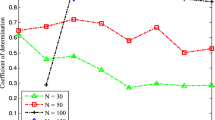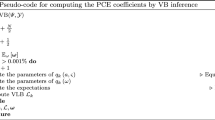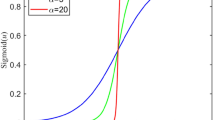Abstract
Polynomial chaos expansion (PCE) has been proven to be a powerful tool for developing surrogate models in the field of uncertainty and global sensitivity analysis. The computational cost of classical PCE is unaffordable since the number of terms grows exponentially with the dimensionality of inputs. This considerably restricts the practical use of PCE. An efficient approach to address this problem is to build a sparse PCE. Since some basis polynomials in representation are highly correlated and the number of available training samples is small, the sparse PCE obtained by the original least square (LS) regression using these samples may not be accurate. Meanwhile, correlation between the non-influential basis polynomial and the important basis polynomials may disturb the correct selection of the important terms. To overcome the influence of correlation in the construction of sparse PCE, a full PCE of model response is first developed based on partial least squares technique in the paper. And an adaptive algorithm based on distance correlation is proposed to select influential basis polynomials, where the distance correlation is used to quantify effectively the impact of basis polynomials on model response. The accuracy of the surrogate model is assessed by leave-one-out cross validation. The proposed method is validated by several examples and global sensitivity analysis is performed. The results show that it maintains a balance between model accuracy and complexity.













Similar content being viewed by others
References
Abdi H (2010) Partial least squares regression and projection on latent structure regression (PLS regression). Wiley Interdisciplinary Rev: Computational Statistics 2(1):97–106
Abraham S, Raisee M, Ghorbaniasl G, Contino F, Lacor C (2017) A robust and efficient stepwise regression method for building sparse polynomial chaos expansions. J Comput Phys 332:461–474
Alwart H. Singular value decomposition (svd) and generalized singular value decomposition (gsvd). Encyclopedia Measurement Statistics 2006; 907–912
Berveiller M, Sudret B, Lemaire M (2006) Stochastic finite element: a non-intrusive approach by regression. European J Computational Mechanics/Revue Européenne de Mécanique Numérique 15(1–3):81–92
Blatman G, Sudret B (2008) Sparse polynomial chaos expansions and adaptive stochastic finite elements using a regression approach. Comptes Rendus Mécanique 336(6):518–523
Blatman G, Sudret B (2010a) Efficient computation of global sensitivity indices using sparse polynomial chaos expansions. Reliab Eng Syst Saf 95(11):1216–1229
Blatman G, Sudret B (2010b) An adaptive algorithm to build up sparse polynomial chaos expansions for stochastic finite element analysis. Probabilistic Engineering Mechanics 25(2):183–197
Blatman G, Sudret B (2011) Adaptive sparse polynomial chaos expansion based on least angle regression. J Comput Phys 230:2345–2367
Bratley P, Fox BL (1988) ALGORITHM 659 implementing Sobol’s quasirandom sequence generator. ACM Trans Math Softw 14(1):88–100
Chen T, Martin E (2009) Bayesian linear regression and variable selection for spectroscopic calibration. Anal Chim Acta 631(1):13–21
Cheng K, Lu Z (2018a) Sparse polynomial chaos expansion based on D-MORPH regression. Appl Math Comput 323:17–30
Cheng K, Lu Z (2018b) Adaptive sparse polynomial chaos expansions for global sensitivity analysis based on support vector regression. Comput Struct 194:86–96
Cheng K, Lu Z, Zhou Y, Shi Y, Wei Y (2017) Global sensitivity analysis using support vector regression. Appl Math Model 49:587–598
Cherkassky V, Ma Y (2004) Practical selection of SVM parameters and noise estimation for SVM regression. Neural Netw 17(1):113–126
Da Veiga S (2015) Global sensitivity analysis with dependence measures. J Stat Comput Simul 85(7):1283–1305
Daghir-Wojtkowiak E, Wiczling P, Bocian S, Kubik Ł, Kośliński P, Buszewski B et al (2015) Least absolute shrinkage and selection operator and dimensionality reduction techniques in quantitative structure retention relationship modeling of retention in hydrophilic interaction liquid chromatography. J Chromatogr A 1403(4):54–62
Efron B, Stein C (1981) The jacknife estimate of variance. Ann Stat 9(3):586–596
Fang KT, Li FZ, Sudjianto A (2005) Design and modeling for computer experiments
Farkas O, Héberger K (2015) Comparison of ridge regression, partial least-squares, pairwise correlation, forward- and best subset selection methods for prediction of retention indices for aliphatic alcohols. ChemInform
Friedman J, Tibshirani R, Hastie T (2010) Regularization paths for generalized linear models via coordinate descent. J Stat Softw. 33(1)
Ghanem RG, Spanos PD (1991) Stochastic finite element method: response statistics. In: Stochastic finite elements: a spectral approach. Springer, N Y, pp 101–119
Ghiocel DM, Ghanem RG (2002) Stochastic finite-element analysis of seismic soil–structure interaction. J Eng Mech 128(1):66–77
Hoerl AE, Kennard RW (1970) Ridge regression: biased estimation for nonorthogonal problems. Technometrics 12:55–70
Kucherenko S (2010) A new derivative based importance criterion for groups of variables and its link with the global sensitivity indices. Comput Phys Commun 181(7):1212–1217
Looss B, Lemaître P (2014) A review on global sensitivity analysis methods. Operations Res/Computer Sci Interfaces 59:101–122
Lyons R (2013) Distance covariance in metric spaces. Ann Probab 41(5):3284–3305
Molinaro AM, Simon R, Pfeiffer RM (2005) Prediction error estimation: a comparison of resampling methods. Bioinformatics 21(15):3301–3307
Morris MD (1991) Factorial sampling plans for preliminary computational experiments. Technometrics 33(2):161–174
Owen AB. A robust hybrid of lasso and ridge regression. Stanford University 2006
Paruggia M. (2004) Sensitivity analysis in practice: a guide to assessing scientific models. J R Stat Soc Ser A (Statistics in Society).
Pettersson MP, Iaccarino G, Nordstrom J (2015) Polynomial chaos methods for hyperbolic partial differential equations. Springer Math Eng 10:978–973
Polat E, Gunay S (2015) The comparison of partial least squares regression, principal component regression and ridge regression with multiple linear regression for predicting pm10 concentration level based on meteorological parameters. J Data Sci 13(4):663–692
Raisee M, Kumar D, Lacor C (2015) A non-intrusive model reduction approach for polynomial chaos expansion using proper orthogonal decomposition. Int J Numer Methods Eng 103(4):293–312
Rajabi MM, Ataie-Ashtiani B, Simmons CT (2015) Polynomial chaos expansions for uncertainty propagation and moment independent sensitivity analysis of seawater intrusion simulations. J Hydrol 520:101–122
Razavi S, Gupta HV (2015) What do we mean by sensitivity analysis? The need for comprehensive characterization of “global” sensitivity in earth and environmental systems models. Water Resour Res 51(5):3070–3092
Saltelli A, Chan K, Scott EM (2000) Sensitivity analysis. J. Wiley & Sons
Shao Q, Younes A, Fahs M, Mara TA (2017) Bayesian sparse polynomial chaos expansion for global sensitivity analysis. Comput Methods Appl Mech Eng 318:474–496
Sobol IM (1993) Sensitivity estimates for nonlinear mathematical models. Mathematical Modelling Computational Experiments 1(4):407–414
Sobol IM (2001) Global sensitivity indices for nonlinear mathematical models and their Monte Carlo estimates. Math Comput Simul 55(1–3):271–280
Sobol IM (2003) Theorems and examples on high dimensional model representation. Reliab Eng Syst Saf 79(2):187–193
Soize C, Ghanem R (2004) Physical systems with random uncertainties: chaos representations with arbitrary probability measure. SIAM J Sci Comput 26(2):395–410
Song S, Wang L (2017) Modified GMDH-NN algorithm and its application for global sensitivity analysis. J Comput Phys 348:534–548
Stone M. (1974) Cross-validatory choice and assessment of statistical predictions. J R Stat Soc Ser B (Methodological) 111–47
Sudret B (2008) Global sensitivity analysis using polynomial chaos expansions. Reliab Eng Syst Saf 93(7):964–979
Szekely GJ, Rizzo ML (2014) Partial distance correlation with methods for dissimilarities. Ann Stat 42(6):2382–2412
Székely GJ, Rizzo ML, Bakirov NK. Measuring and testing dependence by correlation of distances. Ann Stat 2007; 2769–94
Szepietowska K et al (2017) Sensitivity analysis based on non-intrusive regression-based polynomial chaos expansion for surgical mesh modelling. Struct Multidiscip Optim 2:1–19
Tibshirani R (1996) Regression shrinkage and selection via the lasso. J R Stat Soc Ser B 58(1):267–288
Wang HW, Wu ZB, Meng J (2006) Partial least-squares regression-linear and nonlinear methods. National Defense Industry Press, Beijing
Wang P, Lu ZZ, Xiao SN (2017) A generalized separation for the variance contributions of input variables and their distribution parameters. Appl Math Model 47:381–399
Wold H. (1985) Partial least squares. Encyclopedia Statistical Sci
Xiao S, Lu Z, Wang P (2018a) Multivariate global sensitivity analysis for dynamic models based on wavelet analysis. Reliab Eng Syst Saf 170
Xiao S, Lu Z, Wang P (2018b) Multivariate global sensitivity analysis for dynamic models based on energy distance. Struct Multidiscip Optim 57:279–291
Zhao W, Wang W (2013) Application of partial least squares regression in response surface for analysis of structural reliability. Engineering Mechanics 30(2):272–277
Author information
Authors and Affiliations
Corresponding author
Additional information
Responsible Editor: Shapour Azarm
Publisher’s Note
Springer Nature remains neutral with regard to jurisdictional claims in published maps and institutional affiliations.
Rights and permissions
About this article
Cite this article
Zhou, Y., Lu, Z. & Cheng, K. Sparse polynomial chaos expansions for global sensitivity analysis with partial least squares and distance correlation. Struct Multidisc Optim 59, 229–247 (2019). https://doi.org/10.1007/s00158-018-2062-8
Received:
Revised:
Accepted:
Published:
Issue Date:
DOI: https://doi.org/10.1007/s00158-018-2062-8




